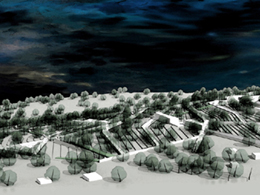STUDENTS PROJECTS
2010
Students: Stella Papazoglou, Marianna Kazakou
Tutor: Vana Tentokali
Aristotel University of Thessaloniki, A.U.T.H.
Date: Thursday 02 July 2010
Our diploma project revolves around the old rail station in the village Milies, which is located in Mount Pelion of Greece and aims to connect this region with the settlement above. The train trip and the region, the mount of mythic creatures Kentaurwn, as a terrain, as nature, as a myth were the two main aspects that attracted us towards this approach.
We are exploring what takes place between the routes and the stasis, that is in their in between, and trying to discover the relations who associate them.
In order to find our tools for the design process, we used an approach which began with an impulsive tracing of the train route in text, a design and a model. Then we tried to describe it in structural terms, so that we could decode our own early synthesis.

The study of Victor Vasarely's work and mainly the way he used the grid, gave us another perspective towards studying and analyzing our region, meaning its mass and void as well as its topography.

So, what we detect is a void system, a series of folds and a grid system in the region.
The three systems above constituted our design tools.

We use this void system by projecting them in the region. After we re-place them according to functional standards (accesses, ground quality, pedestrian's movements, and train's path) into the station's region, those voids operate as guides for our second tool, the folding. Our aim is to create a new sculptural terrain, which would almost totally accessible and passable, and to it would also have the capacity to function regardless of the routes we would design in the landscape. Lastly, the grid stands for the footprints on top of which our built environment will evolve, that are ramps, stairs as well as some buildings.


As we moved on to a smaller scale and trying to solve the relation of the pedestrian with the train route and the station's location as well as with the very close settlement, we chose as an approach, the intelligible continuity of the train's route for the pedestrian. So we studied the spatial states we came across during our train trip and we translated them into spatial qualities of our intervention. Those qualities are able to give shape to the elements we discussed above, having as a purpose either to continue the route of the pedestrian, or invert this terminal station to a starting point for the walker.

We created two parallel paths of routes and ramps using the ground's folds, and another almost vertical to them ascension route with ramps and stairs the grid's footprints.


The overall movement we were aiming for was basically immiscible where both systems are completely related to each other. This route proceeds through the buildings that accomplish the narration through an alteration of mass and void. Each building has a different theme following the growing cultural trend of the region.(image 9 & 10)


As in all different readings and in the complexity of each route, our proposal provides a series of different ways of "going", so that each visitor can choose his own path every single time. There is an alteration of spatial experiences having reasoning from the route of the historic train of Pelion.











